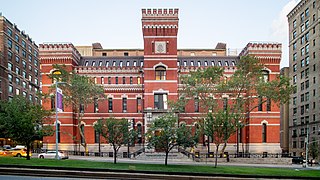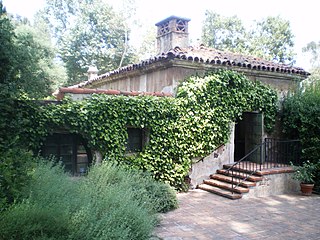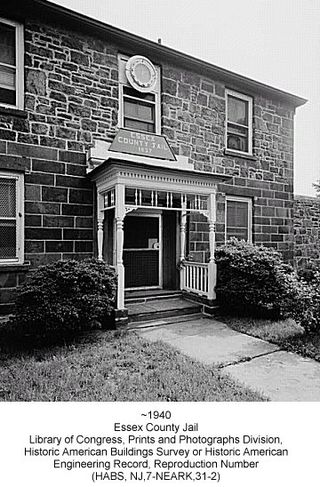
Carthage Jail is a historic building in Carthage, Illinois, listed on the National Register of Historic Places (NRHP). It was built in 1839 and is best known as the location of the 1844 killing of Joseph Smith, founder of the Latter Day Saint movement, and his brother Hyrum, by a mob of approximately 150 men. It was added to the NRHP in 1973 and is operated by the Church of Jesus Christ of Latter-day Saints as a historic site with an adjacent visitors' center.

The Pillsbury A-Mill is a former flour mill located on the east bank of the Mississippi River in Minneapolis, Minnesota. It was the world's largest flour mill for 40 years. Completed in 1881, it was owned by the Pillsbury Company and operated two of the most powerful direct-drive waterwheels ever built, each capable of generating 1,200 horsepower . In 1901 one of the turbines was replaced with a 2,500 horsepower one. Both the mill and its headrace tunnel are contributing resources to the St. Anthony Falls Historic District, which is on the National Register of Historic Places. The mill is also independently on the NRHP. The mill was named a National Historic Landmark in 1966 and has since been converted into the A-Mill Artist Lofts.

The Allegheny County Courthouse in downtown Pittsburgh, Pennsylvania, is part of a complex designed by H. H. Richardson. The buildings are considered among the finest examples of the Romanesque Revival style for which Richardson is well known.

The Park Avenue Armory, also known as Seventh Regiment Armory, is a historic National Guard armory building located at 643 Park Avenue in the Upper East Side neighborhood of Manhattan, New York City. The building is a brick and stone structure built in 1880 and designed in the Gothic Revival style by Charles Clinton.

Lancaster County Courthouse is a historic courthouse in Lancaster, South Carolina. Built in 1828, it has been in continuous use since then. It was designated a National Historic Landmark in 1973, as a possible work of Robert Mills, an important American architect of the first half of the 19th century. It also has the distinction of being the site of the last witch trials to take place in the United States.

The Burlington County Prison is a historic museum property, located next to the Burlington County Jail in Mount Holly Township, Burlington County, New Jersey, United States. Operating from 1811 to 1965, it was the oldest prison in the nation at the time of its closure. Designed by Robert Mills, its design exemplified period thinking in progressive prison design, with individual cells, good ventilation, and fireproof construction. Now operated by a local nonprofit as a museum, it was designated a National Historic Landmark in 1986.

The William Trent House is a historic building located at 15 Market Street in Trenton, Mercer County, New Jersey. It was built in 1719 for William Trent and is the oldest building in Trenton. He founded the eponymous town, which became the capital of New Jersey. It has served as the residence for three Governors. The house was added to the National Register of Historic Places and listed as a National Historic Landmark on April 15, 1970, for its significance as an example of Early Georgian Colonial architecture.

The Old York Gaol is a former colonial prison at Lindsay Road and Main Street in York, Maine. Its oldest portion dating to about 1720, it is one of the oldest prison buildings in the United States, and one of the oldest public buildings in the state of Maine. It was designated a National Historic Landmark in 1968. It is owned by the Museums of Old York and is open for tours between May and October.

Bristol County Jail is a historic jail at 48 Court Street in Bristol, Rhode Island, and home to the Bristol Historical and Preservation Society.

The Debtors' Prison is a historic debtors' prison in Accomac, Virginia. Constructed in 1783 as a house for the Accomack County jailer, it is the oldest public structure in the county. It was converted to use as a debtors' prison in 1824, which purpose it served until 1849. The prison was added to the Virginia Landmarks Register and the National Register of Historic Places in 1976; along with structures in Worsham and Tappahannock, both in Virginia as well, it is one of only three debtors' prisons in the country on the National Register.

The Debtors' Prison is a historic debtors' prison building located in Worsham, Virginia. Constructed in 1787, it is one of three such prisons, all listed on the National Register of Historic Places, remaining in Virginia; the other two are in Accomac and Tappahannock. Of the three, only the one in Worsham was constructed of wood. It is the oldest surviving public building in Prince Edward County, and dates to the time when Worsham was the county seat.

El Molino Viejo, also known as The Old Mill, is a former grist mill in the San Rafael Hills of present-day San Marino, California, United States, and was built in 1816 by Father José María de Zalvidea from the Mission San Gabriel Arcángel. It is the oldest commercial building in Southern California, and was one of the first ten sites in Los Angeles County to be listed on the National Register of Historic Places, receiving the recognition in 1971. The Old Mill has also been designated as a California Historical Landmark.

The Wiscasset Jail and Museum is a historic jail on at 133 Federal Street in Wiscasset, Maine. Built in 1811, it is one Maine's oldest surviving jail buildings, serving as the state's first penitentiary between 1820 and 1824. It is now a museum operated by the Lincoln County Historical Society as the 1811 Lincoln County Museum and Old Jail. It was listed on the National Register of Historic Places in 1970.

The old Essex County Jail is located in the University Heights section of Newark, Essex County, New Jersey, United States. The jail is Essex County's oldest public building and a national landmark of value for its architectural and social history. The complex consists of about 20 structures of various size, age, and function ranging in date from the 1830s to 1930s. Collectively, they represent the evolution of American prison history over 100 years. For the quality of its architecture, its social history, and its links to the 1967 Newark Riots, this jail was added to the National Register of Historic Places on September 3, 1991.

The Llano County Courthouse and Jail were erected separately, but added to the National Register of Historic Places in Texas on December 2, 1977 as one entry. The courthouse, located in the middle of Llano's historic square, was built in 1893. The exterior is made of sandstone, marble, and granite. The interior of the courthouse was damaged by fire in 1932 and again in 1951. It is still in use today by local government. The jail was erected in 1895, with the prisoner cells on the second and third floors, and the ground level solely for the office and living accommodations for the sheriff and his family. The jail was designated a Recorded Texas Historic Landmark 1979, Marker 9448. The courthouse was designated a Recorded Texas Historic Landmark 1980, Marker number 9446.

Built in Warrenton in 1808, the sixth jail in Fauquier County, Virginia ran for only fifteen years before a new jail was erected behind it after a lawsuit with the Commonwealth of Virginia. In those fifteen years the four-cell jail saw death and disease from neglectful conditions. Soon after the 1823 jail was constructed, the 1808 jail was transformed into a jailer's house, so that he and his family could move in and care for the prisoners. A two-story sandstone addition was added onto the original brick structure to serve as a kitchen and second floor bedroom. It was operated as a jail until 1966, when the Fauquier Historical Society saved it from demolition and created a museum.

The former Hancock County Jail is located at 40 State Street in Ellsworth, the county seat of Hancock County, Maine. Built in 1885–86, it has a well-appointed living space for the jailer in the front, and a series of cells in the back. It was operated as a jail until the early 1970s, and is now home to the Ellsworth Historical Society, which operates it as a museum. It was listed on the National Register of Historic Places in 2008 for its architectural and historical significance.

The Old Searcy County Jail is a historic building on Center Street, on the south side of the courthouse square in Marshall, Arkansas. It is a two-story stone structure, built out of local sandstone, with a pyramidal roof topped by a cupola. The front facade, three bays wide, has a central bay that projects slightly, rising to a gabled top, with barred windows at each level. The main entrance is recessed in the rightmost bay. The building's interior houses jailer's quarters on the ground floor and cells on the upper level. Built in 1902, it was used as a jail until 1976, and briefly as a museum thereafter.

The Orleans County Courthouse and Jail Complex is a historic government facility on Main Street in the city of Newport, Vermont, the shire town of Orleans County. The complex includes a fine Romanesque courthouse built in 1886, a wood-frame jailer's quarters built in 1886, and a 1903 brick jail. The complex was listed on the National Register of Historic Places in 1984.

Rockdale County Jail is a historic building at 967 Milstead Ave. in Conyers, Georgia. It was built in 1897 and served as the jail for Rockdale County, Georgia from then until a new jail was built in 1968. It was entered into the National Register of Historic Places (NRHP) on August 26, 1982. It now serves as the headquarters for the Rockdale County Historical Society and is known as the Old Jail Museum.
























